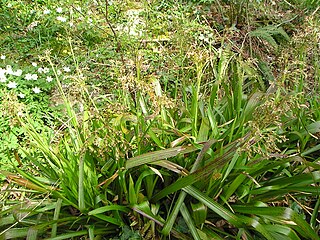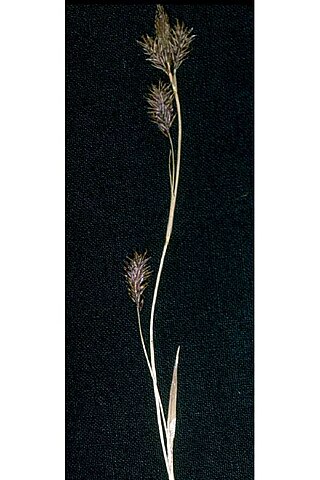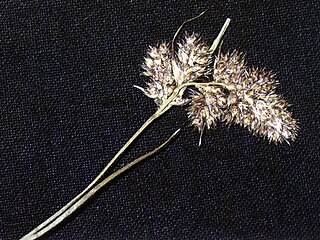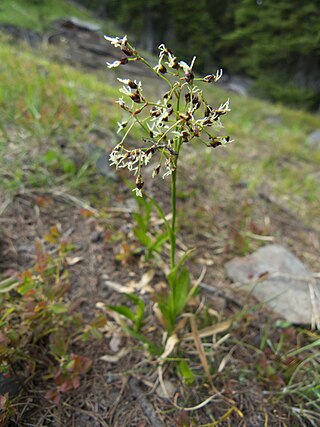
Luzula is a genus of flowering plants in the rush family Juncaceae. The genus has a cosmopolitan distribution, with species occurring throughout the world, especially in temperate regions, the Arctic, and higher elevation areas in the tropics. Plants of the genus are known commonly as wood-rush, wood rush, or woodrush. Possible origins of the genus name include the Italian lucciola or the Latin luzulae or luxulae, from lux ("light"), inspired by the way the plants sparkle when wet with dew. Another etymology sometimes given is that it does derive from lucciola but that this meant a mid-summer field, or from the Latin luculus, meaning a small place; the same source also states that this name was applied by Luigi Anguillara in 1561.

Luzula campestris, commonly known as field wood-rush or Good Friday grass is a flowering plant in the rush family Juncaceae. It is also one of the plants known as chimney sweeps or sweep's broom because of the brush-like appearance of their flowers. This is a very common plant throughout temperate Europe extending to the Caucasus. This species of Luzula is found on all types of native grasslands, and cultivated areas such as lawns, golf-course greens and fields.

Luzula sylvatica, commonly known as greater wood-rush or great wood-rush, is a perennial flowering plant in the rush family Juncaceae.

Carex luzulina is a species of sedge known by the common name woodrush sedge.

Luzula comosa is a species of flowering plant in the rush family known by the common name Pacific woodrush. It is native to western North America from Alaska to California to Colorado, where it can be found in moist spots in forests and meadows and many other types of habitat. It is a perennial herb quite variable in appearance, often forming small, narrow grasslike tufts. The erect inflorescence is tipped with a series of clustered spikelike flowers. The dark brown perianth parts open to reveal 6 stamens tipped with large anthers.
Luzula divaricata is a species of flowering plant in the rush family known by the common name forked woodrush. It is native to the California and Nevada in the United States.

Luzula parviflora is a species of flowering plant in the rush family known by the common name small-flowered woodrush. It has a northern circumboreal distribution.

Luzula spicata is a species of flowering plant in the rush family known by the common name spiked woodrush. It has a circumpolar distribution, occurring throughout the northern Hemisphere in Europe, Asia, and North America. It grows in subalpine and alpine climates. It occurs at low elevations in colder regions, such as tundra; farther south it is restricted mainly to high mountains. It is a perennial herb forming grasslike clumps of several erect, reddish stems up to about 33 centimeters in maximum height. The stem is thick and its base is buried several centimeters in the soil where it attaches to the roots. The inflorescence is an array of several clusters of brown bristle-tipped flowers. The surrounding bracts and the sheaths surrounding the leaf bases are lined with hairs.
Luzula subcongesta is a species of flowering plant in the rush family known by the common name Donner woodrush. It is native to the high mountains of California, from the Klamath Mountains, where its distribution extends into Oregon, to the Sierra Nevada, where it may occur just inside Nevada as well.

Luzula multiflora, the common woodrush or heath wood-rush, is a species of flowering plant in the rush family.

Luzula pilosa is a species of flowering plant in the rush family Juncaceae with the common name hairy wood-rush. The plant is native to northern Europe and western Asia.
Salix orestera is a species of willow known by the common name Sierra willow, or gray-leafed Sierra willow. It is native to the Sierra Nevada of California and western Nevada, where it grows in moist areas in high mountain subalpine and alpine climates. It can also be found in Oregon.

Elachista geminatella is a moth of the family Elachistidae found in Europe.
Primula capillaris is a rare species of flowering plant in the primrose family known by the common name Ruby Mountains primrose, or Ruby Mountain primrose. It is endemic to Nevada in the United States, where it is limited to the Ruby Mountains of Elko County.

Luzula hitchcockii is a species of flowering plant in the rush family known by the common names smooth woodrush and Hitchcock's wood rush. It is native to western North America from British Columbia and Alberta to Oregon to Wyoming. It is sometimes treated as a variety of Luzula glabrata.

Luzula acuminata, the hairy woodrush, is a species of perennial flowering plant in the rush family, Juncaceae, that is native to the Eastern United States and Canada. It is 6–47 centimetres (2.4–18.5 in) tall with its basal leaves being of 6–39 centimetres (2.4–15.4 in) high and 2–11 millimetres (0.079–0.433 in) in diameter. It has cauline leaves are 2.5–11.5 centimetres (0.98–4.53 in) tall and 2–5 millimetres (0.079–0.197 in) wide.
Luzula nivalis, commonly known as arctic wood-rush or less commonly as snowy wood-rush, is a species of perennial rush native to the North American Arctic and Northern Europe. It was described by Polunin (1940) as one of the most abundant, ubiquitous, and ecologically important of all arctic plants.
Luzula wahlenbergii, commonly known as Wahlenberg's woodrush or reindeer wood-rush, is a perennial species of plant in the genus Luzula of the (rush) family Juncaceae.











